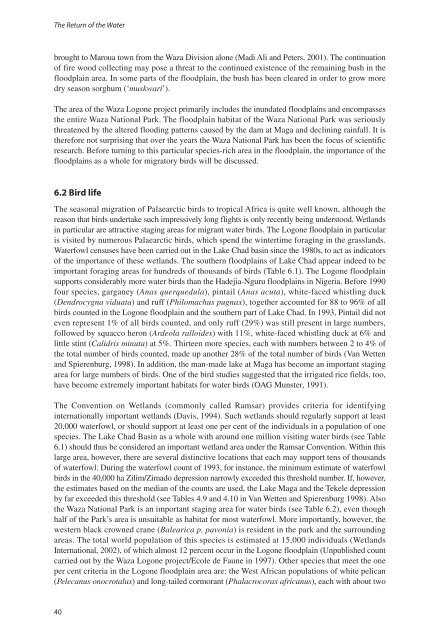The return of the water - IUCN
The return of the water - IUCN
The return of the water - IUCN
You also want an ePaper? Increase the reach of your titles
YUMPU automatically turns print PDFs into web optimized ePapers that Google loves.
<strong>The</strong> Return <strong>of</strong> <strong>the</strong> Water<br />
brought to Maroua town from <strong>the</strong> Waza Division alone (Madi Ali and Peters, 2001). <strong>The</strong> continuation<br />
<strong>of</strong> fire wood collecting may pose a threat to <strong>the</strong> continued existence <strong>of</strong> <strong>the</strong> remaining bush in <strong>the</strong><br />
floodplain area. In some parts <strong>of</strong> <strong>the</strong> floodplain, <strong>the</strong> bush has been cleared in order to grow more<br />
dry season sorghum (‘muskwari’).<br />
<strong>The</strong> area <strong>of</strong> <strong>the</strong> Waza Logone project primarily includes <strong>the</strong> inundated floodplains and encompasses<br />
<strong>the</strong> entire Waza National Park. <strong>The</strong> floodplain habitat <strong>of</strong> <strong>the</strong> Waza National Park was seriously<br />
threatened by <strong>the</strong> altered flooding patterns caused by <strong>the</strong> dam at Maga and declining rainfall. It is<br />
<strong>the</strong>refore not surprising that over <strong>the</strong> years <strong>the</strong> Waza National Park has been <strong>the</strong> focus <strong>of</strong> scientific<br />
research. Before turning to this particular species-rich area in <strong>the</strong> floodplain, <strong>the</strong> importance <strong>of</strong> <strong>the</strong><br />
floodplains as a whole for migratory birds will be discussed.<br />
6.2 Bird life<br />
<strong>The</strong> seasonal migration <strong>of</strong> Palaearctic birds to tropical Africa is quite well known, although <strong>the</strong><br />
reason that birds undertake such impressively long flights is only recently being understood. Wetlands<br />
in particular are attractive staging areas for migrant <strong>water</strong> birds. <strong>The</strong> Logone floodplain in particular<br />
is visited by numerous Palaearctic birds, which spend <strong>the</strong> wintertime foraging in <strong>the</strong> grasslands.<br />
Waterfowl censuses have been carried out in <strong>the</strong> Lake Chad basin since <strong>the</strong> 1980s, to act as indicators<br />
<strong>of</strong> <strong>the</strong> importance <strong>of</strong> <strong>the</strong>se wetlands. <strong>The</strong> sou<strong>the</strong>rn floodplains <strong>of</strong> Lake Chad appear indeed to be<br />
important foraging areas for hundreds <strong>of</strong> thousands <strong>of</strong> birds (Table 6.1). <strong>The</strong> Logone floodplain<br />
supports considerably more <strong>water</strong> birds than <strong>the</strong> Hadejia-Nguru floodplains in Nigeria. Before 1990<br />
four species, garganey (Anas querquedula), pintail (Anas acuta), white-faced whistling duck<br />
(Dendrocygna viduata) and ruff (Philomachus pugnax), toge<strong>the</strong>r accounted for 88 to 96% <strong>of</strong> all<br />
birds counted in <strong>the</strong> Logone floodplain and <strong>the</strong> sou<strong>the</strong>rn part <strong>of</strong> Lake Chad. In 1993, Pintail did not<br />
even represent 1% <strong>of</strong> all birds counted, and only ruff (29%) was still present in large numbers,<br />
followed by squacco heron (Ardeola ralloides) with 11%, white-faced whistling duck at 6% and<br />
little stint (Calidris minuta) at 5%. Thirteen more species, each with numbers between 2 to 4% <strong>of</strong><br />
<strong>the</strong> total number <strong>of</strong> birds counted, made up ano<strong>the</strong>r 28% <strong>of</strong> <strong>the</strong> total number <strong>of</strong> birds (Van Wetten<br />
and Spierenburg, 1998). In addition, <strong>the</strong> man-made lake at Maga has become an important staging<br />
area for large numbers <strong>of</strong> birds. One <strong>of</strong> <strong>the</strong> bird studies suggested that <strong>the</strong> irrigated rice fields, too,<br />
have become extremely important habitats for <strong>water</strong> birds (OAG Munster, 1991).<br />
<strong>The</strong> Convention on Wetlands (commonly called Ramsar) provides criteria for identifying<br />
internationally important wetlands (Davis, 1994). Such wetlands should regularly support at least<br />
20,000 <strong>water</strong>fowl, or should support at least one per cent <strong>of</strong> <strong>the</strong> individuals in a population <strong>of</strong> one<br />
species. <strong>The</strong> Lake Chad Basin as a whole with around one million visiting <strong>water</strong> birds (see Table<br />
6.1) should thus be considered an important wetland area under <strong>the</strong> Ramsar Convention. Within this<br />
large area, however, <strong>the</strong>re are several distinctive locations that each may support tens <strong>of</strong> thousands<br />
<strong>of</strong> <strong>water</strong>fowl. During <strong>the</strong> <strong>water</strong>fowl count <strong>of</strong> 1993, for instance, <strong>the</strong> minimum estimate <strong>of</strong> <strong>water</strong>fowl<br />
birds in <strong>the</strong> 40,000 ha Zilim/Zimado depression narrowly exceeded this threshold number. If, however,<br />
<strong>the</strong> estimates based on <strong>the</strong> median <strong>of</strong> <strong>the</strong> counts are used, <strong>the</strong> Lake Maga and <strong>the</strong> Tekele depression<br />
by far exceeded this threshold (see Tables 4.9 and 4.10 in Van Wetten and Spierenburg 1998). Also<br />
<strong>the</strong> Waza National Park is an important staging area for <strong>water</strong> birds (see Table 6.2), even though<br />
half <strong>of</strong> <strong>the</strong> Park’s area is unsuitable as habitat for most <strong>water</strong>fowl. More importantly, however, <strong>the</strong><br />
western black crowned crane (Balearica p. pavonia) is resident in <strong>the</strong> park and <strong>the</strong> surrounding<br />
areas. <strong>The</strong> total world population <strong>of</strong> this species is estimated at 15,000 individuals (Wetlands<br />
International, 2002), <strong>of</strong> which almost 12 percent occur in <strong>the</strong> Logone floodplain (Unpublished count<br />
carried out by <strong>the</strong> Waza Logone project/Ecole de Faune in 1997). O<strong>the</strong>r species that meet <strong>the</strong> one<br />
per cent criteria in <strong>the</strong> Logone floodplain area are: <strong>the</strong> West African populations <strong>of</strong> white pelican<br />
(Pelecanus onocrotalus) and long-tailed cormorant (Phalacrocorax africanus), each with about two<br />
40












